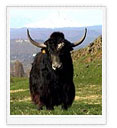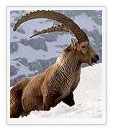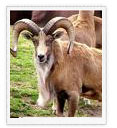

  |
|
| Ladakh TrekkkingToursLadakh TourismMonasteries FestivalsTrekking Adventure & ToursHotels in Ladakh |
     |
Ladakh Trekking Tours :: Wildlife in Ladakh Ladakh Wildlife - Wildlife in LadakhLadakh is a unique wildlife destination, with many rare and exotic animals and birds seen in this high Himalayan plateau. The alpine climate, and rugged mountains are home to many different species of flora and fauna, which you can see on tours to Ladakh. Yak The largest animal of the cold desert is the yak(dong), a yakwild ox. First described only a century ago by the famous Russian naturalist-- explorer, N.M.Przewalski, the wild yak is definitely more imposing than its placid domestic counterpart. Immensely shaggy and weighing about a tone it has curved horns whose tips can be as wide apart as 90 cm. and measure 76 cm. over the curves. It can easily be distinguished by its long black hair, which is tinged with gray at the muzzle. Spending its summers at a height above 6,000 meters, in winter it moves in herds to the lakes, marshes and lower valleys. Nayan All the world's sheep are closely related and zoologists generally believe that each kind is only a variation of the same species. The largest and most magnificent of wild sheep is the nyan also called the Great Tibetan sheep (Ovis ammon). Roughly 200 of these antelope - like animals are found in the extreme eastern portion of Ladakh. The horns of the nyan measure up to 145 cm. and the animal normally remains at a great height, rarely descending to a level below 4,500 meters. Birds Some of the most exotic Himalayan birds can be found in the Ladakh region. Tibetan snow cocks, griffon vultures, lammergeyers or bearded vultures, etc are some of the native birds of Ladakh. One can also find a number of migratory birds in Ladakh including the charming Black-necked Crane Urials The urial or shapu, (Ovis orientalis), which weighs 85 Kg. and has horns measuring upto 99 cm., is the smallest of the world sheep in eastern Asia, its body just about as tall as its horns. These sheep prefer the grassy mountain slopes, usually at a height of 3,000-4,000 meters. The meeting of this species, as is the case with most sheep during December-January and they give birth to their young around May. The need for protection of the urial is great as they are with in easy reach of hunters. Their numbers have been declining rapidly and it is estimated that there are no more than 500 in Ladakh, while a survey by the Wildlife Department of Jammu & Kashmir puts another population in the Markha and Rumbak valleys at only around 34-50.The most common and wide spread of the sheep in the Ladakh region is the bharal or the blue sheep (Pseudois nayaur). Found at an altitude of almost 6,000 meters, in summer they graze in huge herds on the rich and abundant grasses of the alpine meadows. Their brownish-gray coloring provides them with protective camouflage and as they often stand motionless they can be extremely difficult to spot but, when alarmed, bharal will bolt swiftly to safety. Strangely, bharal seem to bear some morphological traits of both sheep and goats. Ibex Of the goats in the region, ibex (Capra ibex) are the most distinctive and beautiful. Sporting a pair of fine curved, spiral horns measuring as much as 147 cm. (the largest on record), the large stocky ibex normally move in herds of 10-16.They prefer the black precipitous rocks and cliffs and consequently roam much higher than the smaller wild goats, descending, however, in winter to lower altitudes to feed and shelter. The Wildlife Department of J&K estimate that around 250 ibex exist in Kanji Nala. Inhabiting the steppes of this Tibetan plateau are too small creatures not generally associated with high altitudes, the Tibetan gazelle (Procapra picticaudata) and the chiru (Pantholops hodgsoni). The former, sighted very rarely on the eastern fringe of Ladakh, sport horns measuring 36 cm. and are generally seen in herds of 5-10. The later also called Tibetan antelopes, are strange little animals with beautiful horns measuring up to 69 cm. Chiru inhabit the Aksai Chin and Tibetan plateau, usually above 5,000 meters. Also found in western Ladakh are the much persecuted musk deer and kiangs- the handsome , sleek, rust and white colored wild asses, whose estimated population is around 1,500. Snow Leopard The snow leopard inhabits the high mountains of Central Asia, and within India, is found along the northern border, in Snow LeopardArunachal Pradesh, Sikkim, Uttar Pradesh, Himachal Pradesh and Jammu and Kashmir.The Ladakh district of Jammu and Kashmir includes a large area of potential habitat and reports indicate that a relatively undistributed snow leopard population may exist in a few sites. Since the Ladakh area is known to support snow leopard populations, and some of the habitat is fairly accessible, this may prove to be a feasible study site for ecological investigation. The snow leopard is considered endangered in every region in which it is found. Three factors contribute towards a decline in its population.Firstly, the animal is hunted by the locals for its valuable pelt and also to protect livestock. Secondly, ungulate prey of the snow leopard, wild sheep and goats, have been reduced by hunting for human consumption and thirdly, domestic livestock has displaced wild ungulates from their grazing areas. If this trend continues, it is doubtful whether the snow leopard will survive, except in a few isolated areas or in captivity. The Fifth International Snow Leopard Symposium , which took place from October 13-15,1986, in srinagar, was attended by representatives from over 21 countries. Its basic purpose is to promote measures and exchange information which will help to ensure the perpetuation of viable breeding populations of the species. Chiru One of the most renowned as well as most endangered animals of Ladakh is Chiru or Tibetan Antelope. It is hunted for its fine underbelly wool used to make Shahtoosh, an incredibly soft woolen fiber. It is usually seen in the Aksai Chin region in small herds. To protect this endangered species, the government has banned trade in Shahtoosh. Bharal This gray-blue sheep is found at altitudes higher than 6000 m. Known as Bharal or Blue Sheep because of its color, it has qualities of both sheep and goats. Brown Bear, Wolf, Lynx High in the mountains, this solitary animal hunts goats, ibex, blue sheep and shapu by following them up and down the slopes in their seasonal migration. During the winter, snow leopards stalk the lower mountains, often feeding on domestic stock. Observations seem to indicate that this animal hunts in the early morning and late afternoons. Despite the heavy toll taken by poachers, the population of the snow leopard in Ladakh is estimated to be roughly 200. With almost 40-50 skins smuggled out of Ladakh in the 1950's, 30-40 in the 1960's and 10-15 still being slipped out, the main enemy of this animal is, undoubtedly, man. Two other carnivores inhabiting this mountain home for the great bears. The medium-sized Himalayan black bear (Selenarctos thlbetanus), a forest dweller, is found up to heights of 4,500 meters in the summer. Like most bears it feeds on practically anything ranging from fruit and ripe corn to sheep, goats, deer and even termites. Its usual home is in dug-out hollows or caves. Further up the mountain lives the more adaptive brown bear(Ursus arctos) which has a population of around 200(of which approximately 20 are found in the Kargil area- the rest in the Zanskar valley). Three or four pairs of black bears have also been spotted here during the months of July and August when fruits like apricots and apples ripen. The wolf population in Ladakh is likely to be around 300 and consists of two basic varieties. The northern race is light fawn and brown whereas the southern is invariably darker. These wolves, probably the most hated predators in Ladakh, hunt in pairs and move over vast territories. It is observed one particular regularly moving across a narrow valley at dusk. The red fox exists in larger numbers but many are, unfortunately trapped for fur. From western Ladakh alone, about skins are possibly smuggled out every year. The stone marten, a pretty, alert and active animal is also hunted for its fur; again about 400 skins are smuggled out annually. |